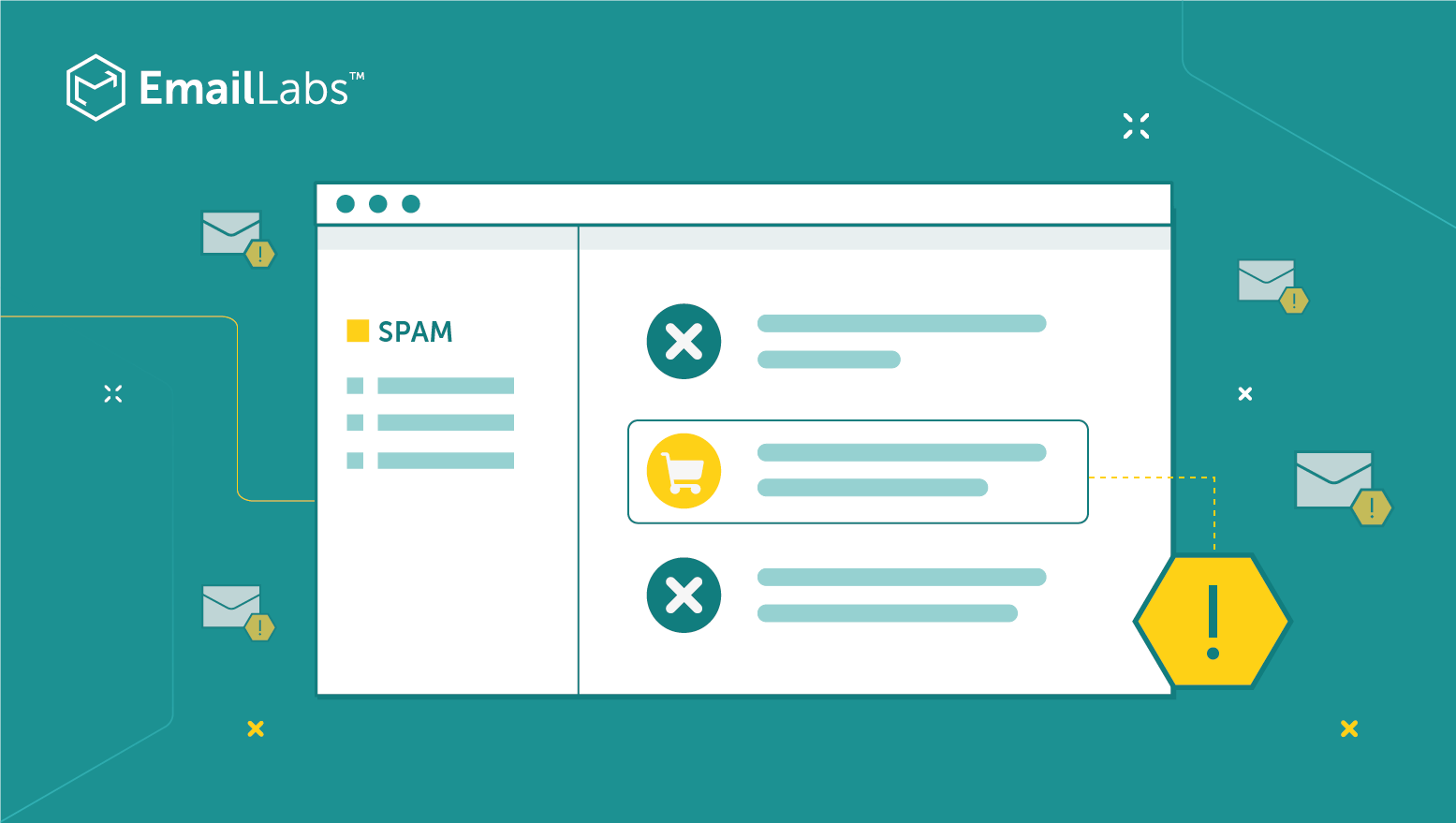
Out of all the things that can go wrong when sending out marketing emails, having your emails end up in the recipient’s spam folder is arguably the most dreaded one – and it’s easy to see why.
Triggering spam filters does not only mean that your carefully crafted message is unlikely to be opened by the individual recipient you sent it to but also that your email address may fall into spam traps set up by email providers, significantly lowering your overall email deliverability.
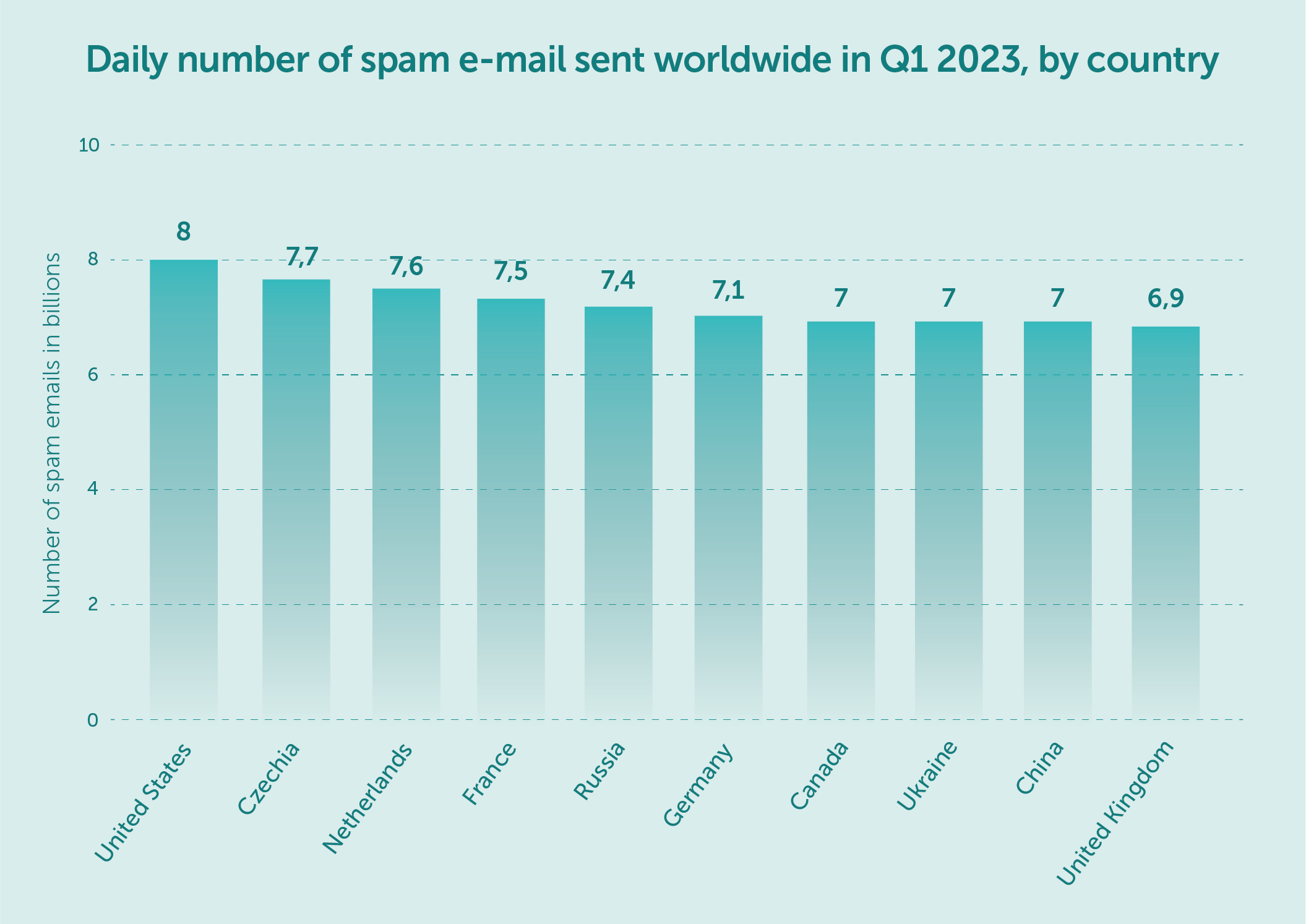
source: statista
It is only natural that you want to avoid this scenario in your email campaigns as much as possible. And while there is no guarantee that your emails will never end up in someone’s spam folder, here are a few tips to help you keep it as unlikely as possible.
This comes as no surprise – monitoring your emails is one of the most important steps you can take in order to proactively avoid the spam folder. With a service such as EmailLabs, you can track the deliverability of your emails in real-time, giving you a detailed overview of how many people are opening and engaging with your messages.
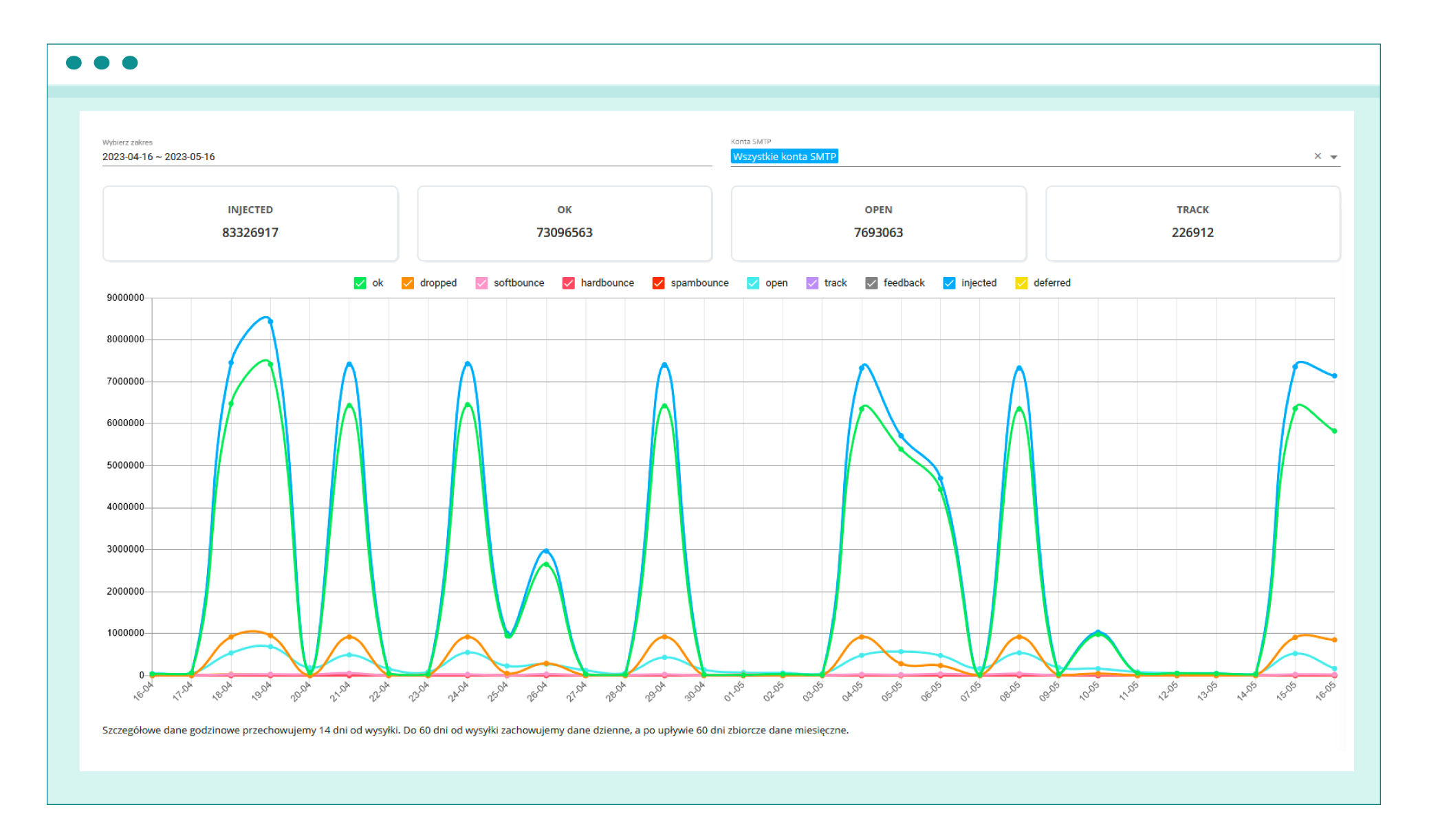
In the EmailLabs panel, you can monitor and analyze every email sent from your domain.
However, this isn’t the only metric you should be monitoring. You also need to keep an eye on bounce rates and spam complaints in order to ensure high email deliverability. All this can shape your sender reputation, which is essential for successful email marketing.
With EmailLabs, you can easily track these metrics, allowing you to make the necessary adjustments in order to maximize your email deliverability. On top of that, our solution allows for secure and flexible delivery of your emails, so you can be sure that they land in the right place.
Maximize your email deliverability and security with EmailLabs!
When designing an email marketing strategy, you need to be honest about what you want to achieve and, more importantly, whether your emails truly provide value to the recipient. While pushing aggressive sales messages can give you some boost in customer engagement, it can also be seen as a red flag by spam filters.
To craft excellent emails, just like with any other form of marketing, you should focus on providing value to the recipient. This means sharing useful information, engaging visuals, and relevant offers. Sometimes, sending fewer emails can be more effective, as it allows you to focus your efforts on the ones that truly matter.
It is safe to say that title and content filters are the simplest yet most effective way for email clients to identify and filter out spam emails. As such, it is important to be aware of the words and phrases that are most likely to trigger these spam filters – even if they seem harmless enough.
Elements often marked as spam include:
If your sender reputation is not high enough, many inbox service providers (ISP) will mark messages containing those as unsolicited emails and, at best, refer them to further inspection.
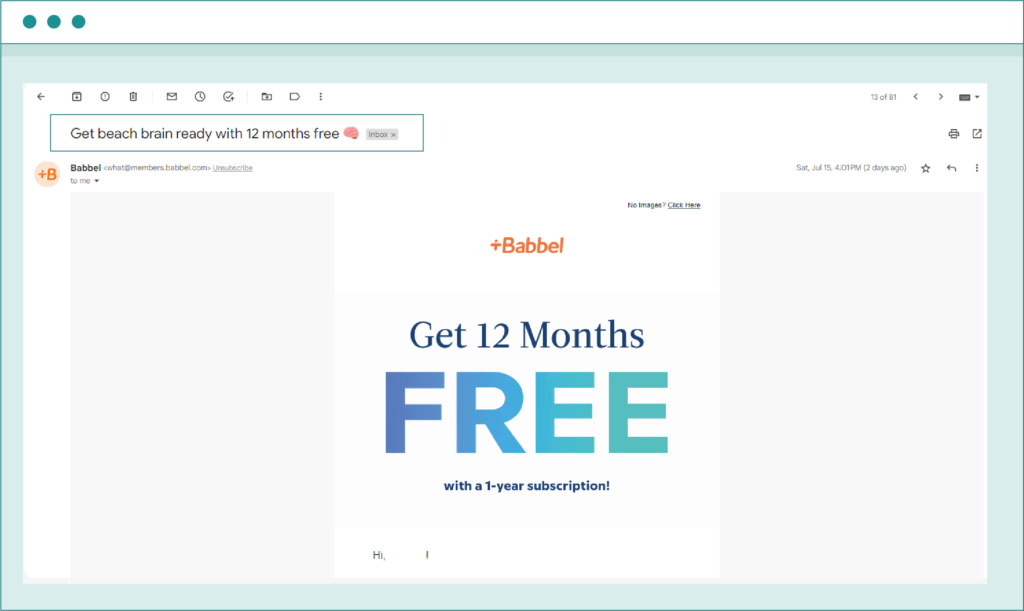
Babbel used a simple title without using sensitive words and only with one emoji
Proper email timing is another thing that can help you avoid having your emails sent to the junk folder.
From the recipient’s perspective, sending the emails at the right time ensures that your message does not get lost in the pile of emails they receive on a daily basis.
From an email service provider’s perspective, sending too many emails or irregularly spaced messages can be seen as a sign of spam email activity, thus triggering their spam filter.
Therefore, it is important to ensure that the timing and frequency of your emails are consistent with what would normally be expected from a verified sender.
Another great way to stay out of the spam folder is by personalizing your emails. This means more than just including the recipient’s name in the subject line – you should also strive to make sure that each message feels like it was tailored to the individual recipient.
The majority of email marketing automation solutions allow you to do this effortlessly.
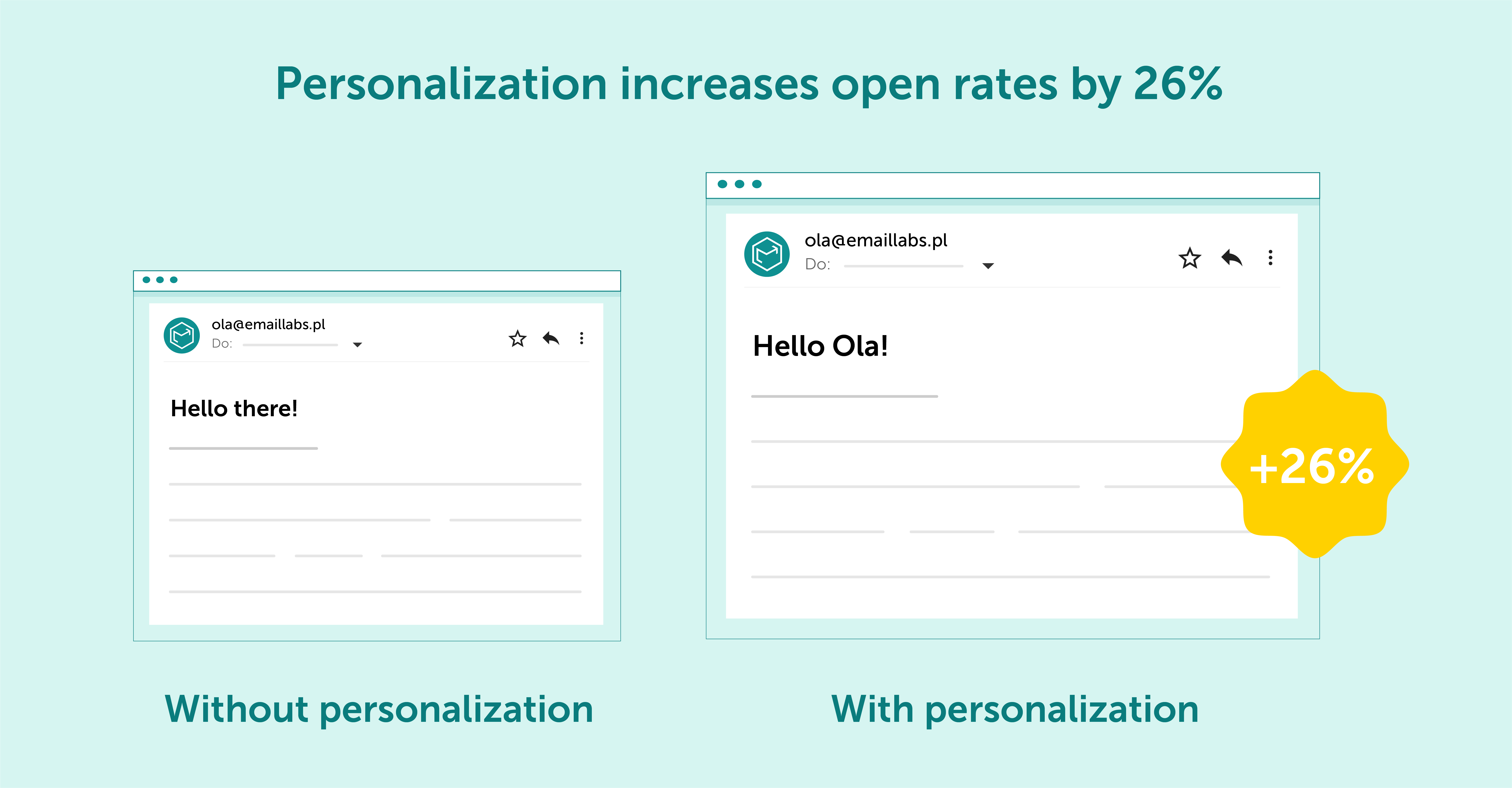
source: Experian
The benefit of this approach is twofold:
Privacy and data processing laws, such as GDPR, require that you give your subscribers an option to easily unsubscribe from your emails with a clear and concise link placed in a visible spot.
In reality, many companies decide to hide the unsubscribe button somewhere deep in the email footer next to a bunch of other links, followed by a double opt-out subscription form. While this may still fall within the legal requirements, it is not what you should do if you want to stay out of the junk folder.
Instead, you should provide a clear and visible, one-click unsubscribe link in the lower part of your email. This is also good practice from a deliverability point of view. The reason is simple – and it isn’t even about email providers.
Simply put, when your recipient gets an email they don’t find interesting, and they can’t find the unsubscribe button easily, they are much more likely to mark your email as spam in order to get rid of it.
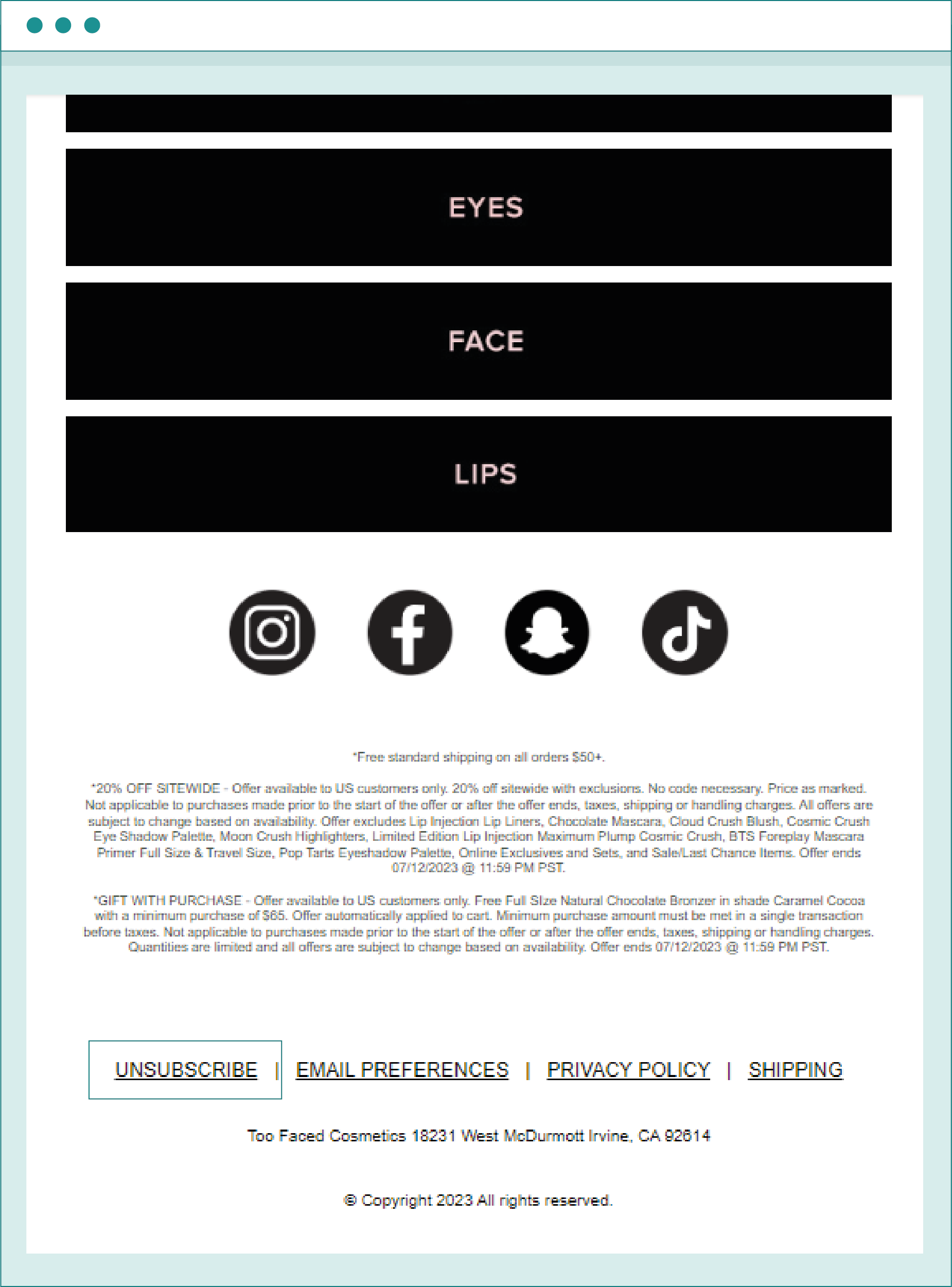
TooFaced has placed a prominent “Unsubscribe” button at the bottom of the message
This, in turn, affects your spam score, making it more likely for your future emails to end up in the spam folder. On top of that, your email subscribers list clears itself, so, contrary to what it may seem, having an unsubscribe link is beneficial for you as well.
Maximize your email deliverability and security with EmailLabs!
Finally, it is important to note that spam filters aren’t just looking at the content and timing of your emails. There are also a few technical best practices you need to keep in mind in order to make sure that your emails pass the automated spam checkers.
Some of them can be solved by choosing the right email service provider. EmailLabs, for instance, can help you maintain and enhance your sender reputation, ensuring that your emails are delivered to the inbox.
It is safe to assume that the majority of marketing emails today are created using some form of HTML template. This opens the door for a much more complex design, including dynamic images, interactive elements, and more.
However, if these templates are not created with valid HTML email code, they can increase the likelihood of your emails ending up in the spam folder. This is because invalid or broken email content can be considered a sign of spam or low-quality emails, triggering the filters.
On the recipient’s side, this is a similar story to the unsubscribe link advice – if your email code is broken, they may mark your emails as spam rather than bother trying to figure out what is wrong.
Rendering your email as a large JPEG or PNG image may seem like a good way to ensure that your email will look just as you intended it to, no matter the email client or device. However, this is a practice that can significantly impact your spam score, as most email spam filters can’t read large images.
Instead, you should make use of what HTML has to offer and only use images for pictures, logos, or any other items that you can describe with a few words in the alt text.
This is also important when speaking about accessibility. Your emails should have approximately a 40/60 image-to-text ratio, and on top of that, you should provide a plain text version for your emails. This will allow the users to read your emails with screen readers and other assistive technologies.
The majority of web apps rely on some sort of scripting language, such as JavaScript or Flash. With their help, you can embed complex objects such as video players, interactive forms, or even games.
But, they can also be used for malicious purposes, which is why most private mailbox providers will block them in order to protect their users. Gmail and Yahoo Mail, for instance, deny sending emails that contain any JS files or embeds.
Therefore, it is important to make sure that your emails don’t contain any potentially unsafe content to avoid having them blocked by the recipient’s email service provider.
Another thing that can trigger spam filters is having broken or potentially dangerous links in your emails. This can happen for a variety of reasons, such as updating the page and changing the URL or even mistyping the link in the first place.
Needless to say, this is a major issue, as it can not only lead to your emails ending up in spam folders but also mark your domain as potentially malicious.
Fortunately, before sending messages to your customers, you can use tools such as Mailchecker.net to point out potentially broken links. So, make sure to double-check all the links in your emails before hitting the “send” button.
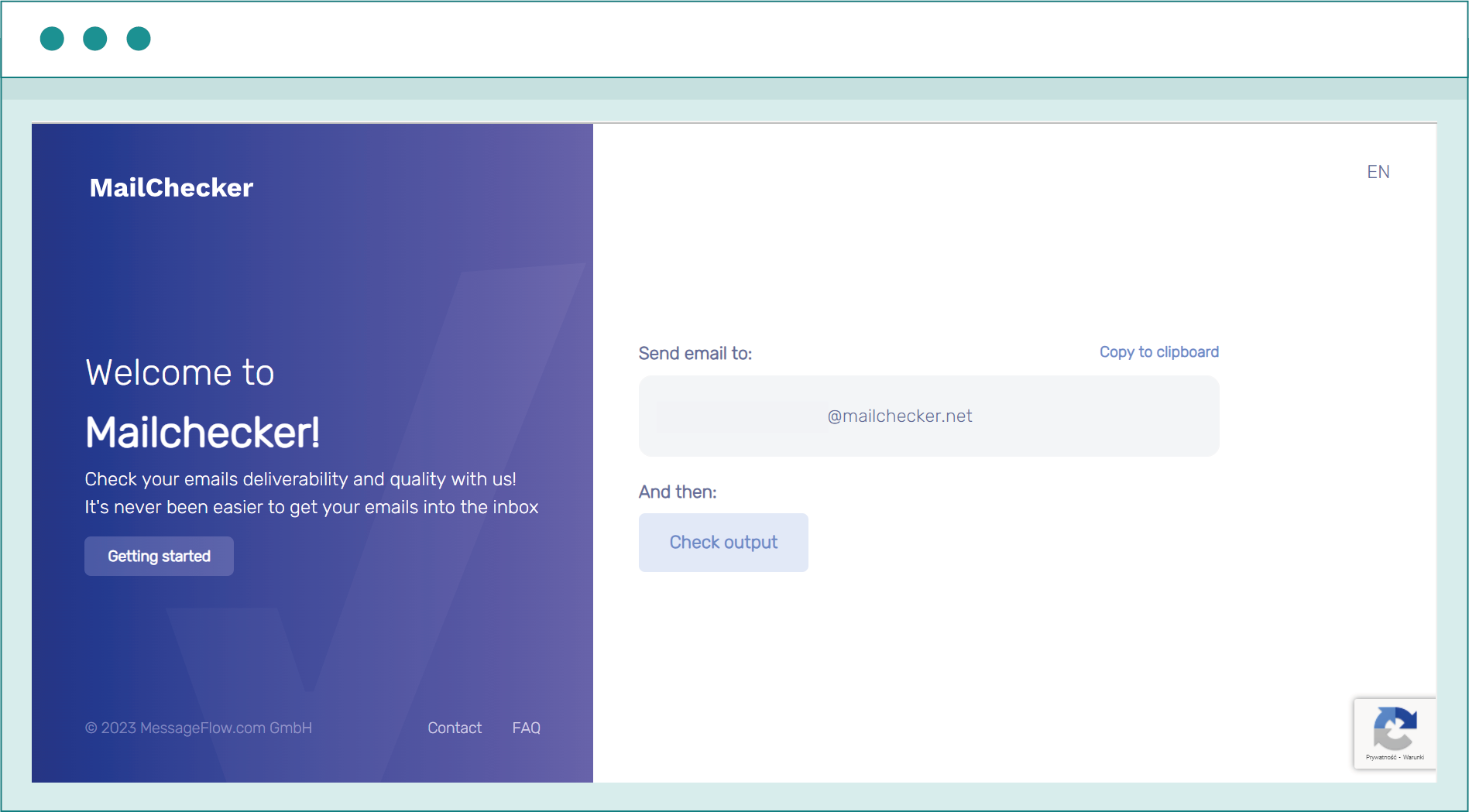
At Mailchecker.net you can check your message for free before sending it to the recipient
Remember that you need to set up protocols and records in order to ensure the successful delivery of your emails.
The most important records are SPF and DKIM. While the former indicates which IP addresses are allowed to send emails from your domain, the latter is used to authenticate the message and ensure that it isn’t modified during delivery.
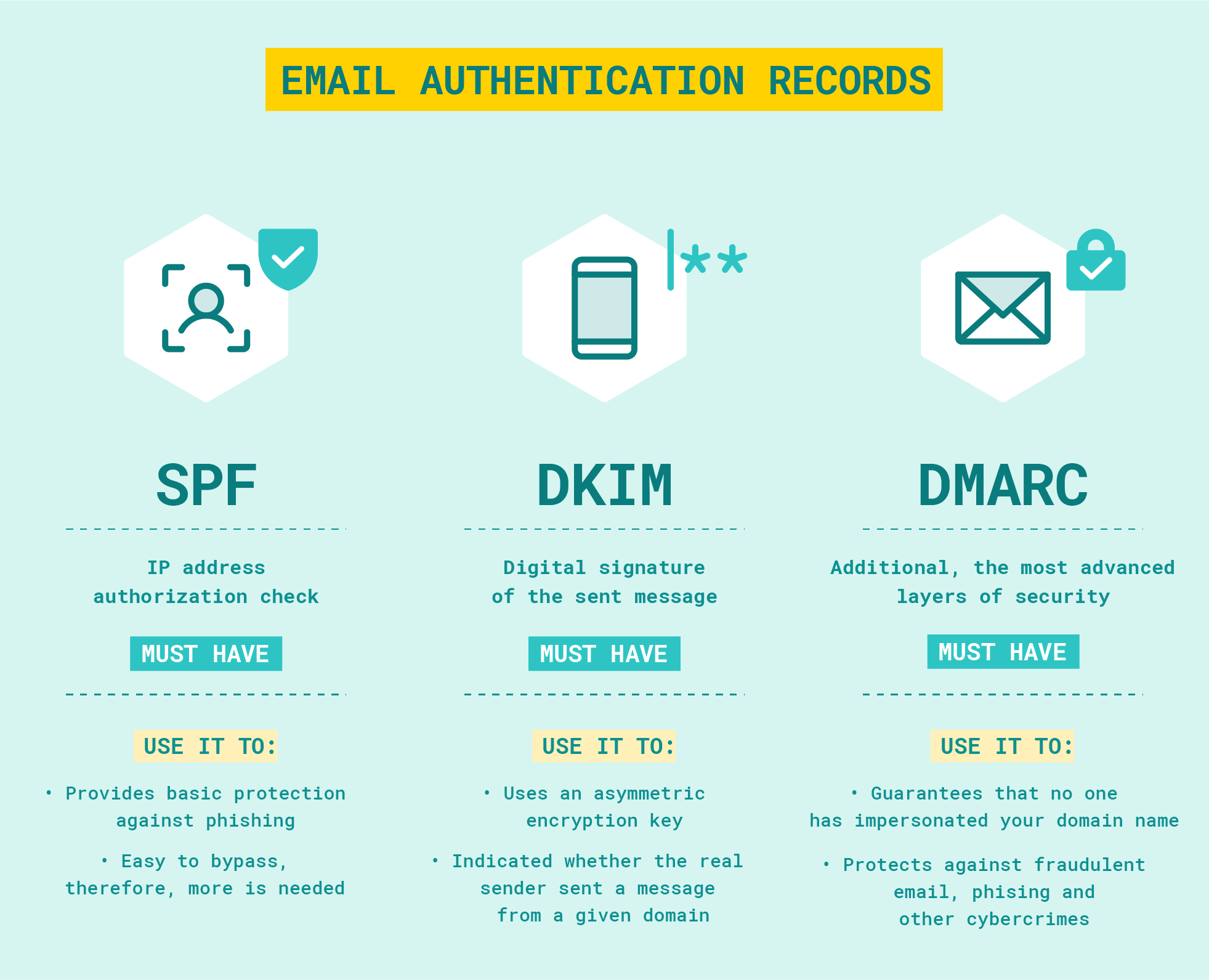
SPF, DKIM, DMARC: Basic elements of email authentication
EmailLabs can help you set up all those protocols and records easily, allowing you to maintain a high email deliverability rate with minimal effort.
Finally, you should always keep an eye on your email reputation which is a score assigned to each IP address and domain used to send emails by most email service providers, and it is used to determine whether or not your emails are marked as spam, trigger malicious activity alerts, or even get blocked by email providers altogether.
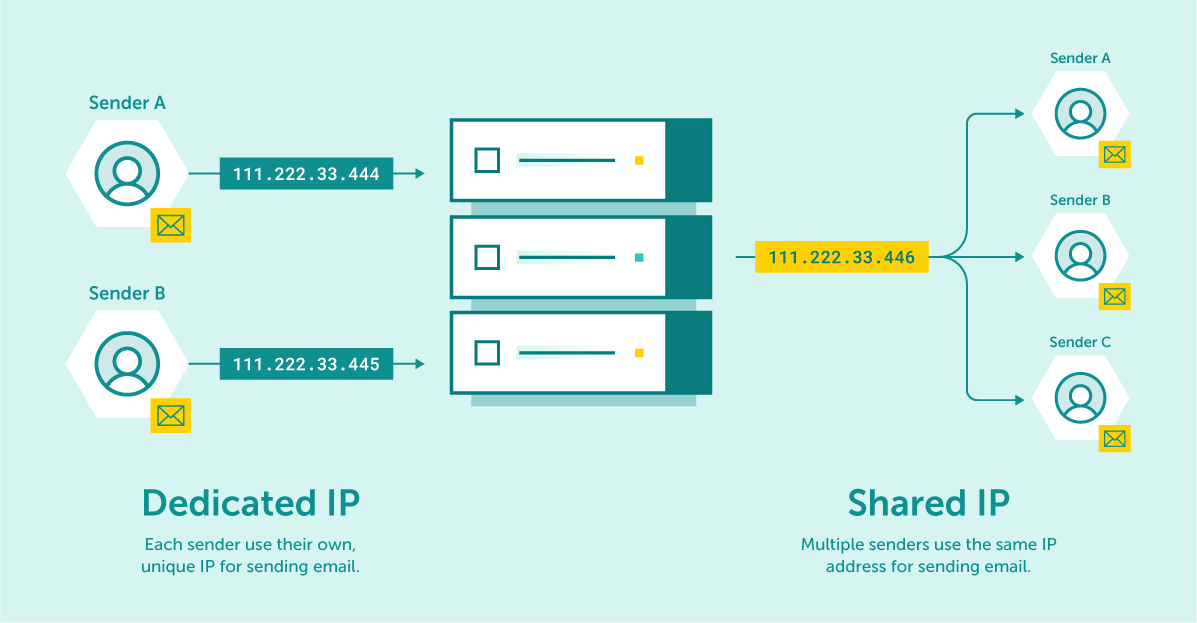
If you want to take care of your reputation as a sender, you should opt to send from a dedicated IP address
Once you notice a drop in your email reputation, you should take immediate action to correct the issue. This can be done by making sure you are following all the best practices listed here, as well as monitoring your emails more closely and tracking any potential issues with your email provider.
Maximize your email deliverability and security with EmailLabs!
Spam mail isn’t a recent issue – it has been plaguing email users since the early days of the internet. As such, various organizations and governments have responded by introducing a number of laws and regulations aimed at protecting users from unwanted emails.
The most widely accepted set of rules is the CAN-SPAM Act, which was introduced by the US Federal Trade Commission in 2003. The act establishes a number of rules for commercial email messages, including:
Similar laws have been adopted by other countries, such as the UK and Canada, so it is important to be aware of them when designing your email marketing strategy.
European Union’s GDPR has introduced a number of rules related to email marketing similar to those of the CAN-SPAM Act as well. Article 5 talks about “lawfulness, fairness, and transparency.” Under this article, companies must show legitimate interest and obtain consent before they can send commercial emails. It does not, however, forbid spam mail in any way.
There are several other steps you can take in order to minimize the chances of your emails ending up in the spam folder. For instance, you should always keep your email list clean and up-to-date by regularly removing inactive users and those with invalid addresses.
If your business does not have enough experience in email campaigns, it may be a good idea to have your marketing emails handled by a third party. EmailLabs, for example, can provide you with properly set up sending servers and help get your messages into the recipient’s inbox. Should any problems arise, our team of experts can help you debug your emails and solve any potential issues.
It is no secret that having your legitimate emails end up in the spam folder is the worst-case scenario for any email marketer. But, with the right strategy and the right tools, you can minimize the chances of it happening.
By following the tips outlined in this article, you can make sure that your emails reach their destination and that your message is seen by as many people as possible. And, if you choose to go with a dedicated email service provider such as EmailLabs, you can rest assured that your emails are delivered securely and reliably every time.
We live in a world where your customers switch seamlessly between laptops, smartphones, and tablets. They navigate a complex digital ecosystem – checking emails, using mobile apps, and reacting...
We are delighted to announce that Vercom S.A., the company behind the EmailLabs project, has successfully completed the ISO 22301 certification process. This significant achievement underscores our commitment to...
EmailLabs, as part of the Vercom group, proudly announces its full commitment to aligning its ICT services with the latest cybersecurity standards. In response to dynamically changing regulations, the...
We are pleased to announce that MessageFlow, a product from the Vercom S.A. group, has received the prestigious CSA (Certified Senders Alliance) Certification. This recognition not only underscores the...
IT & Tech, Pytania i odpowiedzi, Technical
When an email travels from sender to recipient, it passes through several critical components of email infrastructure. At the heart of this journey sits the Mail Transfer Agent (MTA)...
Best practices, Deliverability, Google and Yahoo's Requirements, Pytania i odpowiedzi
The world of email marketing is constantly evolving, and leading mail service providers – Gmail, Yahoo, Microsoft, and Apple – regularly update their guidelines for senders. In recent years,...
Gmail, Google and Yahoo's Requirements
You might have noticed a new item in your Gmail sidebar recently – the “Manage subscriptions” tab, often flagged with a blue notification dot. While Google announced this feature...
IT & Tech, Pytania i odpowiedzi, Technical
When an email travels from sender to recipient, it passes through several critical components of email infrastructure. At the heart of this journey sits the Mail Transfer Agent (MTA)...
Best practices, Deliverability, Google and Yahoo's Requirements, Pytania i odpowiedzi
The world of email marketing is constantly evolving, and leading mail service providers – Gmail, Yahoo, Microsoft, and Apple – regularly update their guidelines for senders. In recent years,...
Gmail, Google and Yahoo's Requirements
You might have noticed a new item in your Gmail sidebar recently – the “Manage subscriptions” tab, often flagged with a blue notification dot. While Google announced this feature...
IT & Tech, Pytania i odpowiedzi, Technical
Efficient email communication isn’t just about sending messages — it also involves integrating email functionality into your business systems and applications. Email APIs (Application Programming Interfaces) serve as the...
One of the most important yet often underestimated elements in shaping a company’s brand perception is the transactional email. In e-commerce, the design of such messages must be carefully...
Google and Yahoo's Requirements, Yahoogle
2024 brought fundamental changes to email marketing, introducing new, stringent requirements for senders. Since February 1, 2024, Google and Yahoo have started enforcing new deliverability rules, primarily targeting bulk...
We live in a world where your customers switch seamlessly between laptops, smartphones, and tablets. They navigate a complex digital ecosystem – checking emails, using mobile apps, and reacting...
Are your campaigns not engaging all recipients as you expect? Do they fail to open your emails or click on links, lowering your campaign effectiveness and email marketing ROI?...
Gmail, Google and Yahoo's Requirements, Updates
Gmail’s educational phase has ended. Google has officially announced the start of a new phase – the Gmail Enforcement Phase – which begins to take effect in November 2025....